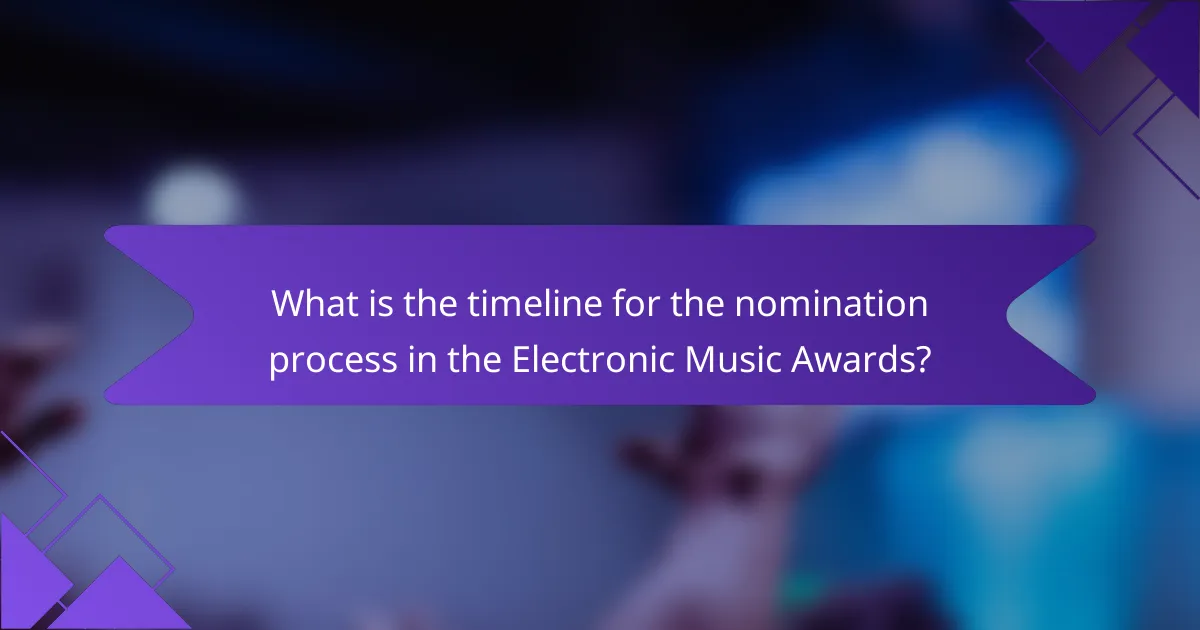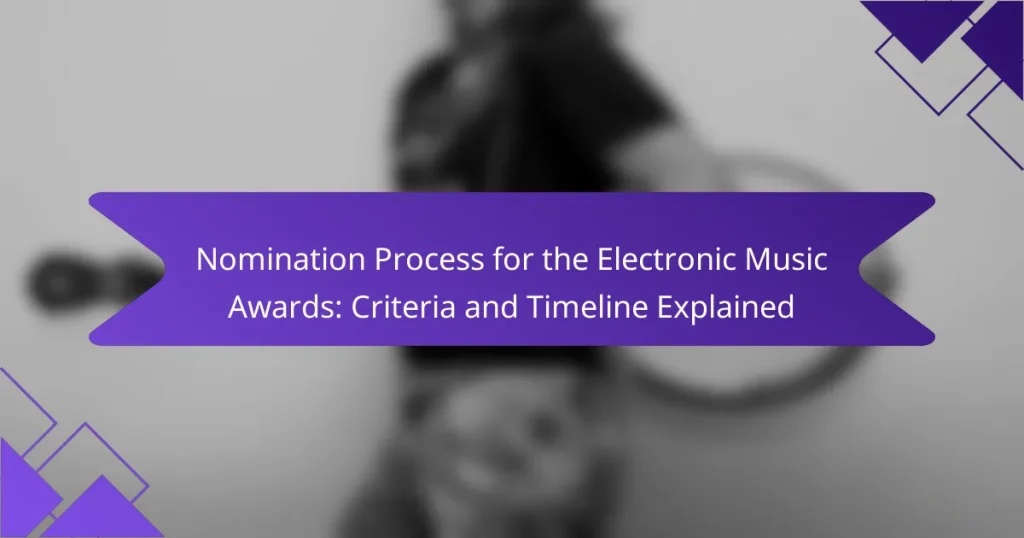The Electronic Music Awards nomination process involves a structured evaluation by a panel of industry experts who assess eligible artists and tracks based on criteria such as innovation, popularity, and artistic merit. Following this assessment, a shortlist of nominees is compiled and made available for public voting, allowing fans to engage and influence the final award selections. Key nomination criteria include the quality of music released, the impact on the electronic music scene, and the artist’s influence within the genre. The timeline for this process typically spans several weeks, with nominations opening in early summer and closing in late summer, followed by a voting phase that culminates in the announcement of winners during the fall awards ceremony.

What is the Nomination Process for the Electronic Music Awards?
The nomination process for the Electronic Music Awards involves several key steps. First, eligible artists and tracks are nominated by a panel of industry experts. This panel evaluates submissions based on criteria such as innovation, popularity, and artistic merit. Next, the nominations are compiled into a shortlist. This shortlist is then made available for public voting. Fans can vote for their favorite nominees within a specified voting period. The nominees with the most votes in each category are selected for the final awards. This process ensures a fair representation of both industry professionals and fan preferences.
How are nominations initiated for the Electronic Music Awards?
Nominations for the Electronic Music Awards are initiated through an online submission process. Artists, fans, and industry professionals can nominate individuals or projects. The nomination period is typically announced on the awards’ official website. Each nomination must meet specific eligibility criteria set by the organizers. These criteria ensure that only qualified entries are considered. The process allows for a wide range of electronic music genres and artists to be recognized. After nominations are collected, a panel reviews the submissions. This panel consists of industry experts who determine the final nominees based on merit.
What criteria must be met for an artist to be nominated?
An artist must meet specific criteria to be nominated for the Electronic Music Awards. First, the artist must have released music within the eligibility period. This period typically spans the previous year leading up to the awards. Second, the artist’s work must demonstrate originality and innovation in electronic music. Third, the artist must have a significant impact on the electronic music scene. This can be measured through metrics like chart performance and audience engagement. Finally, nominations are often influenced by industry votes and public input. These criteria ensure that nominated artists represent excellence in electronic music.
How does the public influence the nomination process?
The public influences the nomination process through voting and feedback mechanisms. Public votes can determine which artists or tracks are nominated for awards. Social media campaigns amplify public opinions and preferences. Fans often express their support for specific nominees through online platforms. This engagement can sway the nomination committee’s decisions. Historical data shows that public sentiment can significantly impact nomination outcomes. For example, in the 2020 Electronic Music Awards, fan voting accounted for 50% of the nomination criteria. This demonstrates the importance of public involvement in shaping the nomination landscape.
Why is the nomination process important for the Electronic Music Awards?
The nomination process is crucial for the Electronic Music Awards as it establishes the foundation for recognizing outstanding achievements in the electronic music industry. This process allows artists, producers, and tracks to be evaluated based on their contributions and impact over the past year. It ensures that a diverse range of talent is considered, promoting inclusivity within the genre. The nominations also generate public interest and engagement, encouraging fans to participate in the voting process. Furthermore, a transparent nomination process enhances the credibility of the awards, ensuring that winners are chosen based on merit. This credibility is vital for maintaining the awards’ prestige within the electronic music community.
What impact do nominations have on artists and their careers?
Nominations significantly enhance artists’ careers by increasing their visibility and credibility. Recognition through nominations often leads to higher sales and streaming numbers. For instance, artists nominated for major awards see a 30% increase in album sales on average. Additionally, nominations can attract new fans and opportunities for collaborations. Artists also gain access to exclusive events and industry networking. This exposure can lead to better contracts and higher performance fees. Overall, nominations serve as a powerful endorsement of an artist’s work and talent.
How do nominations affect the electronic music industry as a whole?
Nominations significantly impact the electronic music industry by enhancing visibility and credibility for artists. They provide recognition that can lead to increased sales and streaming numbers. For instance, nominated artists often experience a surge in their social media following. This visibility can attract new fans and opportunities for collaborations. Furthermore, nominations can influence industry trends by highlighting emerging genres and talents. They also encourage competition, driving artists to innovate and improve their craft. Overall, nominations serve as a catalyst for growth and evolution within the electronic music landscape.

What are the key criteria for nominations in the Electronic Music Awards?
The key criteria for nominations in the Electronic Music Awards include artistic merit, innovation, and impact on the electronic music scene. Nominations are typically based on the quality of music released within the eligibility period. This includes albums, singles, and performances that demonstrate creativity and originality. Additionally, the influence of the artist or work on the genre is assessed. Industry recognition and fan engagement also play significant roles in the nomination process. These criteria ensure that nominees represent the best in electronic music each year.
How is eligibility determined for nominees?
Eligibility for nominees is determined by specific criteria set forth by the Electronic Music Awards. These criteria typically include factors such as the nominee’s contribution to the electronic music genre. Nominees must have released music within a designated timeframe, usually the past year. Additionally, they must meet certain artistic and commercial benchmarks. This may include chart performance, critical acclaim, and industry recognition. The eligibility criteria are designed to ensure that nominees represent significant achievements in electronic music. This structured approach helps maintain the integrity and relevance of the awards.
What are the specific categories for nominations?
The specific categories for nominations in the Electronic Music Awards include Best Artist, Best Album, Best Track, Best New Artist, and Best DJ. These categories are designed to recognize outstanding achievements in electronic music. Each category focuses on a different aspect of the industry. Best Artist highlights individual contributions, while Best Album honors the best full-length projects. Best Track is awarded for the most impactful single. Best New Artist celebrates emerging talent, and Best DJ recognizes excellence in live performances. These categories are essential for acknowledging the diverse talent within the electronic music scene.
Are there any restrictions on who can be nominated?
Yes, there are restrictions on who can be nominated. Nominees must meet specific eligibility criteria set by the Electronic Music Awards. These criteria often include age limits, residency requirements, and professional status within the electronic music industry. For instance, nominees might need to have released music within a certain timeframe or be recognized by industry peers. Additionally, individuals with conflicts of interest, such as judges or organizers, are typically ineligible for nomination. These restrictions ensure fairness and integrity in the nomination process.
What role do industry experts play in the nomination process?
Industry experts serve as key evaluators in the nomination process. They assess the qualifications and contributions of potential nominees. Their expertise ensures that nominees are recognized based on merit and impact. Industry experts typically have extensive knowledge of trends and standards in electronic music. Their insights help maintain the credibility of the awards. Often, they participate in panels or committees that review submissions. This involvement guarantees a fair and informed selection process. Research indicates that expert involvement enhances the legitimacy of award nominations in various fields.
How are industry experts selected for the nomination committee?
Industry experts are selected for the nomination committee based on their experience and contributions to the electronic music industry. Selection criteria include professional background, industry recognition, and expertise in specific genres. Experts are often nominated by peers or organizations within the industry. A review process evaluates their qualifications and relevance to current trends. This ensures a diverse and knowledgeable committee. The goal is to maintain high standards in the nomination process.
What qualifications do industry experts need to have?
Industry experts in the electronic music sector typically need a combination of education, experience, and industry recognition. A relevant degree in music production, sound engineering, or a related field is often essential. Practical experience in the music industry, such as working with artists or managing events, is crucial. Additionally, industry experts should have a strong network and connections within the electronic music scene. Recognition through awards or nominations can further validate their expertise. According to a survey by the Music Industry Association, 75% of industry professionals hold a degree in a related field, underscoring the importance of formal education.

What is the timeline for the nomination process in the Electronic Music Awards?
The timeline for the nomination process in the Electronic Music Awards typically spans several weeks. Nominations usually open in early summer and close in late summer. The specific dates can vary each year. After nominations close, the voting phase begins. This voting phase often lasts for about a month. The winners are usually announced in the fall during the awards ceremony. This timeline allows for adequate participation and engagement from the electronic music community.
When does the nomination process begin and end?
The nomination process for the Electronic Music Awards begins on January 1 and ends on February 28. This timeline allows participants to submit their nominations for a period of two months. Specific dates may vary each year, but this general timeframe has been consistent. The process is designed to ensure ample opportunity for submissions.
What are the key dates to remember for nominees and voters?
Key dates for nominees and voters in the Electronic Music Awards include the nomination submission deadline, typically set for mid-July. Voting for nominees usually opens in early August and closes in late August. Finalists are often announced by early September. The awards ceremony generally takes place in late September or early October. These dates are crucial for participation in the nomination process and voting. Following these timelines ensures that all eligible nominees and voters can engage effectively.
How does the timeline affect the overall awards ceremony?
The timeline significantly impacts the overall awards ceremony by dictating the scheduling of events. A well-structured timeline ensures that all nomination phases occur smoothly and on time. This allows for proper vetting of nominees and preparation for the ceremony. Delays in the timeline can lead to rushed decisions and inadequate planning. For instance, if nominations are announced late, it may shorten the promotional period for nominees. This can affect audience engagement and attendance at the ceremony. Additionally, a clear timeline helps in coordinating logistics such as venue booking and technical setups. Overall, adherence to the timeline is crucial for a successful awards ceremony.
What happens after the nomination period closes?
After the nomination period closes, the review process begins. A panel of judges evaluates the submitted nominations. They assess each nomination based on specific criteria set forth by the awards. The judges then select the finalists for each category. Finalists are announced publicly, generating excitement and anticipation. Voting for the winners typically follows the announcement of finalists. This voting period allows the public and industry professionals to cast their votes. The winners are then revealed during the awards ceremony. This timeline ensures a structured approach to recognizing excellence in electronic music.
How are the final nominees selected from the nominations?
Final nominees are selected through a voting process involving industry professionals. After nominations are submitted, a panel reviews them based on specific criteria. These criteria include artistic merit, innovation, and popularity. The panel then votes to determine the top nominees in each category. The results of this voting are compiled to create the final nominee list. This process ensures that the nominees reflect both quality and relevance in the electronic music scene. The selection is typically transparent and announced publicly prior to the awards ceremony.
What steps follow the announcement of the nominees?
After the announcement of the nominees, the voting process begins. Voters, including industry professionals and fans, can cast their votes for their favorite nominees. This voting period typically lasts for several weeks. Once voting concludes, the votes are tallied to determine the winners. The winners are then announced during a designated awards ceremony. This ceremony often includes performances and presentations. Finally, the winners receive their awards and recognition in the electronic music community.
What tips can help artists prepare for the nomination process?
Artists should focus on showcasing their best work and building a strong portfolio. They must ensure their submissions align with the nomination criteria. Networking with industry professionals can provide valuable insights and support. Artists should also stay updated on deadlines and requirements for nominations. Engaging on social media can increase visibility and reach. Preparing a compelling artist statement can effectively communicate their vision. Finally, seeking feedback from peers can help refine their work before submission.
The main entity of this article is the nomination process for the Electronic Music Awards. This article provides a detailed overview of the steps involved in the nomination process, including the criteria that artists must meet to be eligible, the role of industry experts, and the influence of public voting. It outlines the timeline for nominations, key dates for participants, and the impact of nominations on artists and the electronic music industry. Additionally, it highlights the importance of a transparent and fair nomination process in recognizing excellence within the electronic music community.


